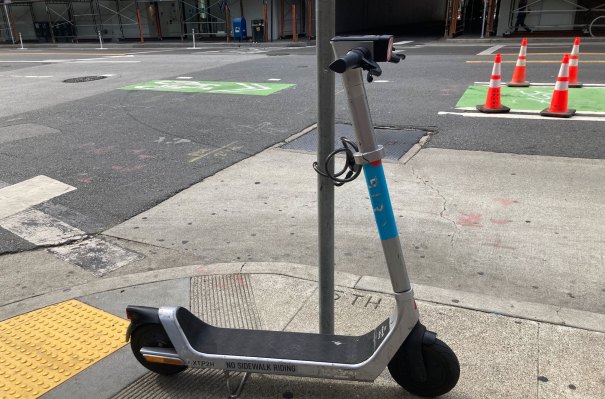Shared micromobility company Bird reported a somewhat head-scratching fourth-quarter and full-year 2022 earnings Friday morning. At first glance, Bird’s earnings show a company that beat Wall Street revenue expectations and is promising free cash flow positivity by the end of this year. But at second glance, that revenue beat isn’t as simple as it seems.
Bird reported revenue of $69.7 million for the fourth quarter of 2022, a big improvement from the $49.5 million reported in the same quarter of 2021. However, that Q4 revenue included $28.8 million of unredeemed preloaded wallet balances collected over the past two years. That means revenue for Q4 is more like $40.9 million — a dip from prior periods.
You might recall that in the third quarter of 2022, Bird reported to the SEC that it had overstated its revenue for the past two years. At the time, the company said it had recorded revenue on certain trips even when customers had lacked sufficient preloaded wallet balances. Bird has also underreported breakage in the past two years, which is the amount of money a customer leaves behind in their preloaded wallet balance. The $28.8 million is Bird’s attempt at playing catch up from those uncounted remainders, and while Bird says it will continue to report breakage as part of revenue in the future, this is pretty much a one-time sweetener to Bird’s top line.
For the sake of keeping things tidy, let’s just deal with the $40.9 million in revenue, which is Bird’s Q4 revenue minus the one-time sweetener. The total cost of revenue for the quarter is reported as $40.25 million, which means Bird barely broke even on a gross profit basis. Additionally, the company’s adjusted operating expenses were $42.3 million, which is a decrease of 29% year-over-year.
Shane Torchiana, Bird’s CEO as of September, told TechCrunch that the merger with Bird Canada in December may have driven up operating expenses slightly. That merger brought Bird around $32 million in new financing, money that Torchiana had previously told TechCrunch Bird needed to raise as part of its overhaul strategy to become profitable.
Another part of that strategy was exiting unprofitable markets. Last October, Bird left dozens of unprofitable markets across the U.S., as well as Norway, Sweden and Germany. Its smaller footprint is one reason the company says its ride revenue is much lighter than last year’s. The company also said the winter months mean fewer riders, and therefore, less revenue.
Revenue isn’t the only thing that’s down from the decreased footprint. Ride volume and rides per scooter fell in Q4 as compared to the same period last year. Bird recorded 8.2 million rides in Q4, which is down from 9.4 million in Q4 2021. For the full year, however, Bird reported a 16% increase in total rides.
However, looking at rides per deployed vehicle per day, Bird is getting less bang for its buck. In Q4 2021, Bird’s scooters got an average of 1.3 rides per day. That number fell to one ride per scooter per day in Q4 of 2022. For the full year, Bird’s scooters got 1.3 rides per day, down from 1.6 rides per day in 2021.
At first blush, the gross transaction value appears to have increased YoY — from $59.5 million in Q4 2021 to $74.8 million in Q4 2022. The company includes that $28.8 million in one-time revenue in its “Reconciliation of Gross Transaction Value to Revenue” as part of its gross transaction value. So really, that’s down YoY, as well.
Finally, as of December 31, 2022, Bird has $33.47 million in unrestricted cash and cash equivalents. At the end of 2021, the company had $128.56 million in cash. That money may not be enough to see Bird through to the end of 2023, and indeed the going concern warning the company issued last quarter is still very much in effect.
What Bird says about all this
Bird says despite all of this it is still focusing on profitability. The company aims to reach adjusted EBITDA this year in the range of $15 to $20 million, get to positive cash flow of $5 to $10 million, and bring its adjusted operating expenses down below $100 million. (Keep in mind in Q2 2022 alone, Bird’s run rate hit $225 million.)
“Obviously we’re in the midst of a transformation, and those numbers don’t fully flow through in Q4,” said Torchiana, who took over as CEO in September and has since implemented a new strategy of cutting costs and increasing asset efficiency. “You’ll see a lot more of the cost reductions [from the past few months] in Q1 [2023].”
Bird also said it hopes to see a 10% to 20% improvement in asset utilization, starting in Q2, as a result of rolling out a new drop engine that has a more data driven approach to where the company places its vehicles and when it rebalances vehicles it’s used in the past. Torchiana says this new system is being trialed in certain markets.
Bird’s stock was trading at $0.18 at market close on Thursday. The company received a warning from the New York Stock Exchange last year that its stock was trading too low, and the company has until September to bring the price up to above $1.
“Our expectation is if the markets are rational, we should see our stock price come up as we deliver against that guidance,” said Torchiana.
Correction: A previous version of this article included an incorrect number for Bird’s Q2 operating expenses.
